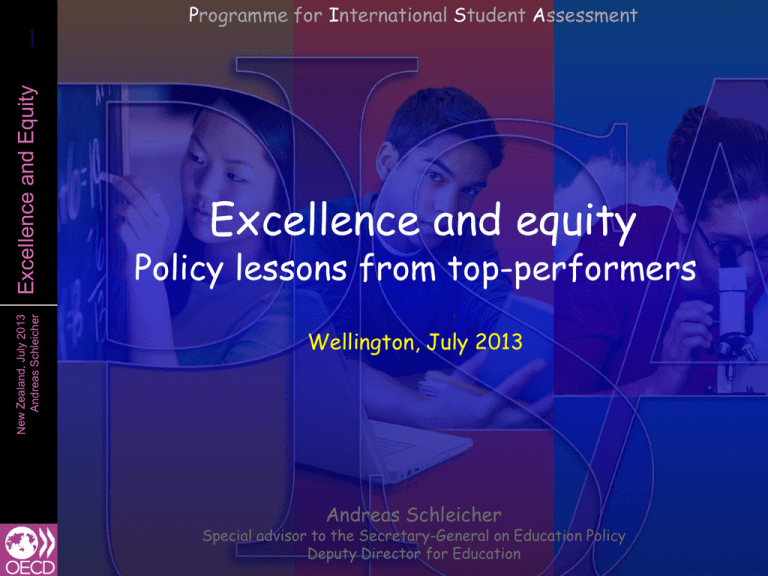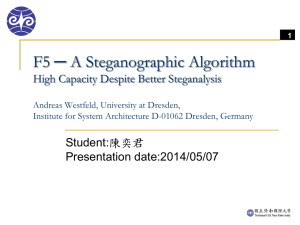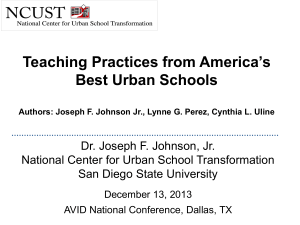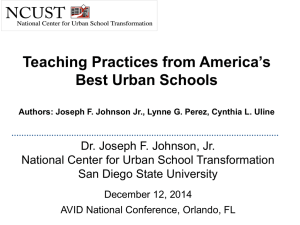Excellence and equity, Policy lessons from top
advertisement

New Zealand, July 2013 Andreas Schleicher Excellence and Equity 11 Programme for International Student Assessment Excellence and equity Policy lessons from top-performers Wellington, July 2013 Andreas Schleicher Special advisor to the Secretary-General on Education Policy Deputy Director for Education ANZOG 2013 Strong performers and successful reformers Andreas Schleicher 22 Across the world more people obtain better qualifications but the pace of change varies hugely across countries A world of change – higher education 30,000 1995 Expenditure per student at tertiary level (USD) 25,000 Cost per student ANZOG 2013 Strong performers and successful reformers Andreas Schleicher 33 20,000 15,000 10,000 5,000 Graduate supply 0 0 10 20 30 40 Tertiary-type A graduation rate (%) 50 60 70 A world of change – higher education 30,000 1995 Expenditure per student at tertiary level (USD) 25,000 Cost per student ANZOG 2013 Strong performers and successful reformers Andreas Schleicher 44 20,000 United States 15,000 10,000 5,000 Graduate supply 0 0 10 20 30 40 Tertiary-type A graduation rate (%) 50 60 70 A world of change – higher education 30,000 2000 25,000 Expenditure per student at tertiary level (USD) ANZOG 2013 Strong performers and successful reformers Andreas Schleicher 55 20,000 15,000 United Kingdom 10,000 5,000 0 0 10 20 30 40 Tertiary-type A graduation rate 50 60 70 A world of change – higher education 30,000 2001 25,000 Expenditure per student at tertiary level (USD) ANZOG 2013 Strong performers and successful reformers Andreas Schleicher 66 20,000 15,000 Australia 10,000 5,000 0 0 10 20 30 40 Tertiary-type A graduation rate 50 60 70 A world of change – higher education 30,000 2002 25,000 Expenditure per student at tertiary level (USD) ANZOG 2013 Strong performers and successful reformers Andreas Schleicher 77 20,000 15,000 10,000 5,000 0 0 10 20 30 40 Tertiary-type A graduation rate 50 60 70 A world of change – higher education 30,000 2003 25,000 Expenditure per student at tertiary level (USD) ANZOG 2013 Strong performers and successful reformers Andreas Schleicher 88 20,000 15,000 10,000 5,000 0 0 10 20 30 40 Tertiary-type A graduation rate 50 60 70 A world of change – higher education 30,000 2004 25,000 Expenditure per student at tertiary level (USD) ANZOG 2013 Strong performers and successful reformers Andreas Schleicher 99 20,000 15,000 10,000 5,000 0 0 10 20 30 40 Tertiary-type A graduation rate 50 60 70 A world of change – higher education 30,000 2005 25,000 Expenditure per student at tertiary level (USD) ANZOG 2013 Strong performers and successful reformers Andreas Schleicher 10 10 20,000 15,000 New Zealand 10,000 5,000 0 0 10 20 30 40 Tertiary-type A graduation rate 50 60 70 A world of change – higher education 30,000 2006 25,000 Expenditure per student at tertiary level (USD) ANZOG 2013 Strong performers and successful reformers Andreas Schleicher 11 11 20,000 15,000 10,000 5,000 0 0 10 20 30 40 Tertiary-type A graduation rate 50 60 70 A world of change – higher education 30,000 2007 25,000 Expenditure per student at tertiary level (USD) ANZOG 2013 Strong performers and successful reformers Andreas Schleicher 12 12 20,000 15,000 10,000 5,000 0 0 10 20 30 40 Tertiary-type A graduation rate 50 60 70 A world of change – higher education 30,000 2008 25,000 Expenditure per student at tertiary level (USD) ANZOG 2013 Strong performers and successful reformers Andreas Schleicher 13 13 20,000 15,000 10,000 5,000 0 0 10 20 30 40 Tertiary-type A graduation rate 50 60 70 A world of change – higher education 30,000 2009 25,000 Expenditure per student at tertiary level (USD) ANZOG 2013 Strong performers and successful reformers Andreas Schleicher 14 14 20,000 15,000 10,000 5,000 0 0 10 20 30 40 Tertiary-type A graduation rate 50 60 70 A world of change – higher education 30,000 2010 25,000 Expenditure per student at tertiary level (USD) ANZOG 2013 Strong performers and successful reformers Andreas Schleicher 15 15 20,000 UK 15,000 Australia New Zealand 10,000 Iceland Poland 5,000 0 0 10 20 30 40 Tertiary-type A graduation rate 50 60 70 A world of change – higher education 30,000 2010 25,000 Expenditure per student at tertiary level (USD) ANZOG 2013 Strong performers and successful reformers Andreas Schleicher 16 16 20,000 US 15,000 10,000 5,000 0 0 10 20 30 40 Tertiary-type A graduation rate 50 60 70 ANZOG 2013 Strong performers and successful reformers Andreas Schleicher 23 23 Benchmarking quality and equity New Zealand, July 2013 Andreas Schleicher Excellence and Equity 24 24 PISA 2009 in brief PISA countries in 2001 2003 2000 2009 2006 1998 Coverage world economy 83% Over half a million of students… 81% 77% 86% 85% 87% representing 28 million 15-year-olds in 74* countries/economies … took an internationally agreed 2-hour test… Goes beyond testing whether students can reproduce what they were taught… … to assess students’ capacity to extrapolate from what they know and creatively apply their knowledge in novel situations … and responded to questions on… their personal background, their schools and their engagement with learning and school Parents, principals and system leaders provided data on… * school policies, practices, resources and institutional factors that help explain performance differences . Data for Costa Rica, Georgia, India, Malaysia, Malta, Mauritius, Venezuela and Vietnam will be published in December 2011 ANZOG 2013 Strong performers and successful reformers Andreas Schleicher 27 27 What 15-year-olds can do Shanghai-China High reading performance Excellence and Equity 28 28 Singapore New Zealand Japan Australia Belgium Poland, Switzerland United States Germany, Sweden France, Ireland Hungary, United Kingdom New Zealand, July 2013 Andreas Schleicher Macao-China Slovenia Slovak Republic, Czech Republic Luxembourg, Israel Austria Dubai (UAE) Average performance of 15-year-olds in 540.000 Korea reading – extrapolate Finland Hong Kong-China and apply Canada 520.000 Netherlands Norway , Estonia Iceland 500.000 Liechtenstein Chinese Taipei Denmark Portugal Italy Latvia Greece 480.000 Spain Croatia Lithuania Turkey 460.000 Russian Federation Chile Serbia 440.000 55 45 35 25 … 17 countries perform below this line Low reading performance High reading performance 29 29 New Zealand, July 2013 Andreas Schleicher Excellence and Equity High average performance Large socio-economic disparities Average performance 15-year-olds Highof average performancein science – extrapolate High social equity and apply Strong socioeconomic impact on student performance Socially equitable distribution of learning opportunities Low average performance Low average performance Large socio-economic disparities High social equity Low reading performance High reading performance Australia 2009 Belgium Canada High average performance High average performance Chile Czech Rep Large socio-economic disparities High social equity Denmark Finland Germany Greece Hungary Iceland Ireland Israel Strong socioSocially equitable Italy economic impact on distribution of learning Japan student performance opportunities Korea Luxembourg Mexico Netherlands New Zealand Norway Poland Portugal Spain Low average performance Low average performance Sweden High social equity SwitzerlandLarge socio-economic disparities UK 55 45 35 25 15 US Low reading performance New Zealand, July 2013 Andreas Schleicher Excellence and Equity 30 30 2009 Durchschnittliche Schülerleistungen im Bereich Mathematik High reading performance Australia Belgium Canada High average performance High average performance Chile Czech Rep Large socio-economic disparities High social equity Denmark Finland Germany Greece Hungary Iceland Ireland Israel Strong socioSocially equitable Italy economic impact on distribution of learning Japan student performance opportunities Korea Luxembourg Mexico Netherlands New Zealand Norway Poland Portugal Spain Low average performance Low average performance Sweden High social equity SwitzerlandLarge socio-economic disparities UK US Low reading performance New Zealand, July 2013 Andreas Schleicher Excellence and Equity 31 31 2009 Durchschnittliche Schülerleistungen im Bereich Mathematik Excellence and Equity 33 33 High performing systems often prioritize the quality of teachers over the size of classes Contribution of various factors to upper secondary teacher compensation costs per student as a percentage of GDP per capita (2004) Salary as % of GDP/capita Instruction time 1/teaching time 1/class size Difference with OECD average Percentage points 15 10 0 -5 Poland United States Sweden Finland Mexico Ireland Iceland Norway Hungary Czech Republic Austria Italy Denmark Netherlands France New Zealand United Kingdom Australia Japan Greece Germany Luxembourg Korea Belgium Switzerland Spain -10 Portugal New Zealand, July 2013 Andreas Schleicher 5 High reading performance Australia Belgium Canada High average performance High average performance Chile Czech Rep Large socio-economic disparities High social equity Denmark Finland Germany Greece Hungary Iceland Ireland Israel Strong socioSocially equitable Italy economic impact on distribution of learning Japan student performance opportunities Korea Luxembourg Mexico Netherlands New Zealand Norway Poland Portugal Spain Low average performance Low average performance Sweden High social equity SwitzerlandLarge socio-economic disparities UK US Low reading performance New Zealand, July 2013 Andreas Schleicher Excellence and Equity 40 40 2009 Durchschnittliche Schülerleistungen im Bereich Mathematik High reading performance Australia Belgium Canada High average performance High average performance Chile Czech Rep Large socio-economic disparities High social equity Denmark Finland Germany Greece Hungary Iceland Ireland Israel Strong socioSocially equitable Italy economic impact on distribution of learning Japan student performance opportunities Korea Luxembourg Mexico Netherlands New Zealand Norway Poland Portugal Spain Low average performance Low average performance Sweden High social equity SwitzerlandLarge socio-economic disparities UK US Low reading performance New Zealand, July 2013 Andreas Schleicher Excellence and Equity 41 41 2000 Durchschnittliche Schülerleistungen im Bereich Mathematik High reading performance Australia Belgium Canada High average performance High average performance Chile Czech Rep Large socio-economic disparities High social equity Denmark Finland Germany Greece Hungary Iceland Ireland Israel Strong socioSocially equitable Italy economic impact on distribution of learning Japan student performance opportunities Korea Luxembourg Mexico Netherlands New Zealand Norway Poland Portugal Spain Low average performance Low average performance Sweden High social equity SwitzerlandLarge socio-economic disparities UK US Low reading performance New Zealand, July 2013 Andreas Schleicher Excellence and Equity 42 42 2000 Durchschnittliche Schülerleistungen im Bereich Mathematik 43 43School performance and socio-economic background School performance and students’ socio-economic background within schools Student performance and schools’ socio-economic background Private school Public school in rural area Score Public school in urban area 700 Student performance New Zealand, July 2013 Andreas Schleicher Excellence and Equity New Zealand 493 200 -2 Disadvantage -1 0 1 PISA Index of socio-economic background 2 Advantage New Zealand, July 2013 Andreas Schleicher Excellence and Equity 44 44 Changes in performance by type of task Increase percentage correct 10 9 OECD 8 Japan 7 6.5 6 5 4 Japan 3 2 1 0 0.8 OECD 1.7 1.7 Japan OECD Multiple-choice - reproducing knowledge Open-ended - constructing knowledge High impact on outcomes New Zealand, July 2013 Andreas Schleicher Excellence and Equity 50 50 Quick wins Must haves Achieving excellence with equity Low feasibility High feasibility Money pits Low hanging fruits Low impact on outcomes High impact on outcomes New Zealand, July 2013 Andreas Schleicher Excellence and Equity 51 51 Quick wins Must haves Commitment to universal achievement Capacity at point of delivery Coherence Incentive structures and accountability Resources where they yield most Gateways, instructional systems Low feasibility High feasibility Money pits Low hanging fruits Low impact on outcomes High impact on outcomes 52 52 A commitment to education and the belief Quick wins New Zealand, July 2013 Andreas Schleicher Excellence and Equity Must haves that competencies can be learned and Commitment to universal therefore all children can achieve Incentive structures achievement and accountability Universal educational standards and Capacity as the approach to at personalisation point of delivery heterogeneity in the studentResources body where they yield Clear articulation who is responsible formost Gateways, ensuring student success and to whom instructional systems Coherence Low feasibility High feasibility Money pits Low hanging fruits Low impact on outcomes New Zealand, July 2013 Andreas Schleicher Excellence and Equity 54 54 High impact on outcomes Quick wins Must haves Commitment to universal achievement Incentive structures and accountability Capacity Clear ambitious goals that are shared across at point of delivery the system and Resources aligned with high stakes where they yield most gateways and instructional systems Gateways, Well established delivery chain through which instructional systems curricular goals translate into instructional Coherence systems, instructional practices and student learning (intended, implemented and achieved) Low feasibility High feasibility High level of metacognitive content of instruction Innovative learning environments Money pits Low hanging fruits Low impact on outcomes High impact on outcomes New Zealand, July 2013 Andreas Schleicher Excellence and Equity 55 55 Capacity at the point of delivery Quick wins Must haves and retaining high quality Attracting, developing universal teachers and schoolCommitment leaders andto a work Incentive structures organisation in which theyachievement can use their and accountability Capacity potential at point of delivery Instructional leadership and human resource Resources management in schools where they yield most Keeping teaching an attractive profession Gateways, System-wide career development instructional systems Coherence Low feasibility High feasibility Money pits Low hanging fruits Low impact on outcomes Teacher in-service development No matter how good the pre-service education for teachers is … it cannot prepare teachers for rapidly changing challenges throughout their careers High-performing systems rely on ongoing professional to… … update individuals’ knowledge of a subject in light of recent advances … update skills and approaches in light of new teaching techniques, new circumstances, and new research … enable teachers to apply changes made to curricula or teaching practice New Zealand, July 2013 Andreas Schleicher Excellence and Equity 56 56 … enable schools to develop and apply new strategies concerning the curriculum and teaching practice … exchange information and expertise among teachers and others … help weaker teachers become more effective . Effective professional development is on-going… … includes training, practice and feedback, and adequate time and follow-up support Relatively few teachers participate in the kinds of professional development which they find has the largest impact on their work Comparison of teachers participating in professional development activities and teachers reporting moderate or high level impact by types of activity TALIS Average % 100 90 80 70 60 50 40 30 20 10 Participation Impact Participation Impact Participation Impact Participation Impact Participation Impact Participation Impact Participation Impact Participation Impact Participation 0 Impact OECD Programme for International Student Assessment PISA Strong performers and successful reformers Andreas Schleicher 13 October 2011 57 57 Individual Qualification Informal Reading Courses and Professional Mentoring Observation Education and programmes dialogue to professional workshops development and peer visits to other conferences collaborative improve literature network observation schools and seminars research teaching Relatively few teachers participate in the kinds of professional development which they find has the largest impact on their work Comparison of teachers participating in professional development activities and teachers reporting moderate or high level impact by types of activity OECD Programme for International Student Assessment PISA Strong performers and successful reformers Andreas Schleicher 13 October 2011 58 58 SIN plc High impact on outcomes 59 59 New Zealand, July 2013 Andreas Schleicher Excellence and Equity Incentives, accountability, knowledge management Quick wins Must haves Aligned incentive structures Commitment to universal Incentive structures For students achievement and accountability Capacity How gateways affect the strength, direction, clarity and nature of at point ofthe delivery incentives operating on students at each stage of their education Degree to which students Resources have incentives to take tough courses and study hard where they yield most Opportunity costs for staying in school and performing well Gateways, For teachers instructional systems Coherence Make innovations in pedagogy and/or organisation Low feasibility Improve their own performance and the performance of their colleagues Pursue professional development opportunities that lead to stronger pedagogical practices High feasibility A balance between vertical and lateral accountability Effective instruments to manage and share knowledge and spread innovation – communication within the system and with stakeholders around it Money pits Low hanging fruits A capable centre with authority and legitimacy to act Low impact on outcomes School autonomy, accountability and student performance Impact of school autonomy on performance in systems with and without PISA score in reading accountability arrangements 500 495 490 New Zealand, July 2013 Andreas Schleicher Excellence and Equity 60 60 School autonomy in resource allocation Schools with more autonomy 480 Schools with less autonomy Systems with more accountability Systems with less accountability System’s accountability arrangements High impact on outcomes New Zealand, July 2013 Andreas Schleicher Excellence and Equity 61 61 Quick wins Must haves Investing resources where they can make Commitment to universal Incentive structures most of a difference achievement and accountability Capacity Alignment of resources with key challenges (e.g. at point of delivery attracting the most talented teachers to the Resources most challenging classrooms) where they yield most Effective spending choices that prioritise high Gateways, quality teachers over smaller classes instructional systems Coherence Low feasibility High feasibility Money pits Low hanging fruits Low impact on outcomes High impact on outcomes 62 62 Commitment to universal achievement Excellence and Equity New Zealand, July 2013 Andreas Schleicher Quick wins Must haves Capacity at point of delivery Incentive structures and accountability Resources where they yield most Gateways, instructional systems Coherence Coherence Low feasibilityof policies and practices Alignment of policies across all aspects of the system Coherence of policies over sustained periods of time Consistency of implementation Money pits Fidelity of implementation (without excessive control) High feasibility Low hanging fruits Low impact on outcomes High impact on outcomes New Zealand, July 2013 Andreas Schleicher Excellence and Equity 63 63 Quick wins Must haves Commitment to universal achievement Capacity at point of delivery Coherence Incentive structures and accountability Resources where they yield most Gateways, instructional systems Low feasibility High feasibility Money pits Low hanging fruits Low impact on outcomes ANZOG 2013 Strong performers and successful reformers Andreas Schleicher 64 64 Why equity has become so central to economic and social well-being New Zealand, July 2013 Andreas Schleicher Excellence and Equity 65 65 Low skills and economic outcomes Increased likelihood of failure (16-65 year olds) 3.5 In lowest two quintiles of personal income 3.0 Unemployed 2.5 Received social assistance in last year 2.0 1.5 1.0 0 1 2 3 Number of skills domains with low performance Odds are adjusted for age, gender and immigration status. 4 Did not receive investment income in last year New Zealand, July 2013 Andreas Schleicher Excellence and Equity 66 66 Low skills and social outcomes Odds ratios Has fair to poor health 2.6 Does not volunteer for charity or non-profit organizations Poor understanding of political issues facing country Poor level of general trust 2.4 2.2 2.0 1.8 1.6 Higher propensity of believing people try to take of advantage of others Lower propensity to reciprocate 1.4 1.2 1.0 Level 5 Level 4 Level 3 Level 2 Odds are adjusted for age, gender, pand immigration status. Level 1 Poor political efficacy New Zealand, July 2013 Andreas Schleicher Excellence and Equity 67 67 Average school systems High performers in PISA Some students learn at high levels All students learn at high levels Uniformity Embracing diversity Curriculum-centred Learner-centred Learning a place Learning an activity Low status of the teaching profession Countries attract and develop high quality teachers Prescription Informed profession New Zealand, July 2013 Andreas Schleicher Excellence and Equity 68 68 Education reform trajectories The old bureaucratic system Some students learn at high levels Student inclusion The modern enabling system All students need to learn at high levels Curriculum, instruction and assessment Routine cognitive skills, rote learning Learning to learn, complex ways of thinking, ways of working Teacher quality Few years more than secondary High-level professional knowledge workers Work organisation ‘Tayloristic’, hierarchical Flat, collegial Accountability Primarily to authorities Primarily to peers and stakeholders Excellence and Equity Find out more about PISA at… OECD www.pisa.oecd.org U.S. White House www.data.gov New Zealand, July 2013 Andreas Schleicher 69 69 Email: Andreas.Schleicher@OECD.org – All national and international publications – The complete micro-level database Thank you ! … and remember: Without data, you are just another person with an opinion





